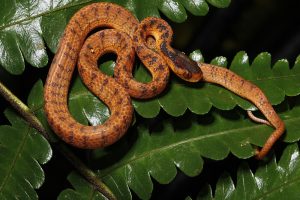A devil-horned newt, a blind cavefish, and an iridescent snake: these were among the 224 new species identified in the Greater Mekong region in 2020, the World Wildlife Fund (WWF) said in a report this week.
Among the catalogue of novel creatures listed in the report, which was released Wednesday, were dozens of fishes, amphibians, and reptiles, in addition to 155 new plant species, including a new species of mulberry tree in Vietnam and “the only known succulent bamboo species, found in Laos.” The list also includes a new species of primate, the Popa langur, discovered near Mt. Popa in Myanmar, which can be identified by “broad white rings fully encircling the eyes, a crest of hair, and forward facing whiskers.”
These new discoveries “demonstrate that the region is still a frontline for scientific exploration and a hotspot of species diversity,” the WWF report stated, something that results from the region’s “complex geological and climatic history, and its diverse landscapes, including extensive karstic regions.” According to the WWF, more than 3,000 new species have been discovered in the region, which includes Myanmar, Thailand, Cambodia, Laos, and Vietnam, since 1997.
In order to perform the sometimes tricky work of identifying new species, scientists used measurements and samples from museum collections to compare species and identify key differences in the newly discovered flora and fauna, the report stated. Not all of these were found in remote rural areas: the report documents the discovery of Amomum foetidum, a new species of ginger, in a plant shop in Sakon Nakhon Province, in northeastern Thailand.
But even as researchers scramble to catalogue and identify the region’s full ecological bounty, it faces immense risks from habitat loss and other encroachments. “Many species go extinct before they are even discovered, driven by habitat destruction, diseases spread by human activities, predation and competition brought by invasive species, and the devastating impacts of illegal and unsustainable wildlife trade,” the WWF report stated.
Thomas Ziegler, a curator at the University of Cologne’s Institute of Zoology, wrote in the report’s introduction that studying the differences between species can help determine the range of species and the specific threats to their survival. “A better understanding of the protected area coverage of threatened species will greatly assist the conservation prioritization of neglected wildlife,” Ziegler wrote, noting that many endangered species were not yet on the IUCN Red List of Threatened Species.
The threat to the region’s wildlife is a direct result of the economic integration that has knitted the region together, and to other parts of Asia, over the past three decades. Since the end of the Cold War saw the Greater Mekong region transition “from a battlefield into a marketplace,” as Thai Prime Minister Chatichai Choonhavan said of Indochina in 1988, roads and highways have opened up once-remote parts of subcontinental Southeast Asia, bringing in their wake the hurricane of the free market, often unbounded by robust or effective legal frameworks.
The fact that so many new species are still being discovered is a testament to how rich the region’s ecology is, and how much of the Greater Mekong is still to be explored. But with every passing year, absent meaningful action, human development is set to encroach further into these areas, narrowing the space in which this bounty of nature can thrive.
“In an increasingly globalized world, we have to take a step back and reconsider our behaviors,” Ziegler wrote. “If we learn to use natural resources more carefully and sustainably, then this current crisis may help us make critical progress in conserving wildlife and wild places.”

































